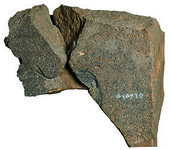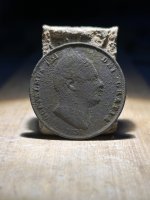DeepseekerADS
Gold Member
- Mar 3, 2013
- 14,880
- 21,725
- Detector(s) used
- CTX, Excal II, EQ800, Fisher 1260X, Tesoro Royal Sabre, Tejon, Garrett ADSIII, Carrot, Stealth 920iX, Keene A52
- Primary Interest:
- Other
Ancient Rock Believed to Offer Key Evidence of Biblical Account | TheBlaze.com
Dec. 16, 2014 11:00am Sharona Schwartz
A rock found in Israel and currently on display at New York’s Metropolitan Museum of Art offers new evidence supporting the Bible’s description of the rule of King David, archaeology experts believe.
The stone’s inscription is believed by archaeologists to support the biblical account of King David’s dynasty. (Courtesy: The Israel Museum, Jerusalem/Israel Antiquities Authority/Photo by Meidad Suchowolski).
Archaeologists believe the stone’s inscription supports the biblical account of King David’s dynasty. (Photo courtesy the Israel Museum, Jerusalem/Israel Antiquities Authority/photo by Meidad Suchowolski)

The stone’s inscription, which appears to refer to King David’s dynasty, is believed to have been written in 830 B.C., only 150 years after he reigned.
A recent article by the Biblical Archaeology Society described the inscription referencing the Davidic dynasty as “extraordinary” and a discovery that substantiates the biblical narrative of the storied king:
The inscription hails from Tel Dan in northern Israel and commemorates the conquests of Hazael, king of Aram-Damascus, enemy of the ancient kingdoms of Israel and Judah. Hazael claims to have killed both Jehoram, king of Israel, and Ahaziahu, king of “the House of David” — or Judah. That the nation of Judah is referred to as the “House of David” is significant because it is the only archaeological evidence of a historical David — a belief that had been hotly debated prior to this discovery — thus substantiating part of the Biblical narrative.
The Jewish Telegraphic Agency reported Monday that that the rock is one of the items featured in the Met’s “Assyria to Iberia at the Dawn of the Classical Age” exhibit.
The museum called it “the earliest extra-biblical reference to the House of David.”
“There is no doubt that the inscription is one of the most important artifacts ever found in relation to the Bible,” Eran Arie, curator of Israelite and Persian periods at the Israel Museum, wrote in the exhibit catalog, according to JTA.
JTA reported that the rock measures 13 inches by 16 inches and has 13 lines of surviving text.
In the museum’s catalog for the exhibit, Arie wrote that the inscription bearing David’s name is a “clear indication that the ‘House of David’ was known throughout the region and that the king’s reputation was not a literary invention of a much later period.”
This “clearly validates the biblical description of a figure named David becoming the founder of the dynasty of Judahite kings in Jerusalem,” Arie wrote.
JTA described Arie’s translation of the dramatic text:
What is clear is that the Aram-Damascene king Hazael brags of having killed 70 kings, including of Israel and of the “House of David.” (The round number, scholars agree, is probably exaggerated, although Hazael did have a reputation for being ruthless and successful.)
The breaks in the stone neither obstruct nor obscure the “bytdvd,” or House of David, inscription, which remains “absolutely intact and clear,” said Ira Spar, professor of history and ancient studies at Ramapo College in New Jersey and a research Assyriologist at the Metropolitan Museum.
Epigraphers and biblical historians agree almost unanimously that the letters “bytdvd” refer to the House of King David, according to Spar.
“While it is clear that David was king of Israel, the archaeological evidence for the extent of his kingdom remains unclear,” Spar told JTA.
Steven Fine, a Jewish history professor at Yeshiva University and director of the Center for Israel Studies, believes that there is keen interest in the public for viewing biblical artifacts.
“It’s part of the grappling with secularization that makes this so important to some people,” Fine told JTA.
Dec. 16, 2014 11:00am Sharona Schwartz
A rock found in Israel and currently on display at New York’s Metropolitan Museum of Art offers new evidence supporting the Bible’s description of the rule of King David, archaeology experts believe.
The stone’s inscription is believed by archaeologists to support the biblical account of King David’s dynasty. (Courtesy: The Israel Museum, Jerusalem/Israel Antiquities Authority/Photo by Meidad Suchowolski).
Archaeologists believe the stone’s inscription supports the biblical account of King David’s dynasty. (Photo courtesy the Israel Museum, Jerusalem/Israel Antiquities Authority/photo by Meidad Suchowolski)

The stone’s inscription, which appears to refer to King David’s dynasty, is believed to have been written in 830 B.C., only 150 years after he reigned.
A recent article by the Biblical Archaeology Society described the inscription referencing the Davidic dynasty as “extraordinary” and a discovery that substantiates the biblical narrative of the storied king:
The inscription hails from Tel Dan in northern Israel and commemorates the conquests of Hazael, king of Aram-Damascus, enemy of the ancient kingdoms of Israel and Judah. Hazael claims to have killed both Jehoram, king of Israel, and Ahaziahu, king of “the House of David” — or Judah. That the nation of Judah is referred to as the “House of David” is significant because it is the only archaeological evidence of a historical David — a belief that had been hotly debated prior to this discovery — thus substantiating part of the Biblical narrative.
The Jewish Telegraphic Agency reported Monday that that the rock is one of the items featured in the Met’s “Assyria to Iberia at the Dawn of the Classical Age” exhibit.
The museum called it “the earliest extra-biblical reference to the House of David.”
“There is no doubt that the inscription is one of the most important artifacts ever found in relation to the Bible,” Eran Arie, curator of Israelite and Persian periods at the Israel Museum, wrote in the exhibit catalog, according to JTA.
JTA reported that the rock measures 13 inches by 16 inches and has 13 lines of surviving text.
In the museum’s catalog for the exhibit, Arie wrote that the inscription bearing David’s name is a “clear indication that the ‘House of David’ was known throughout the region and that the king’s reputation was not a literary invention of a much later period.”
This “clearly validates the biblical description of a figure named David becoming the founder of the dynasty of Judahite kings in Jerusalem,” Arie wrote.
JTA described Arie’s translation of the dramatic text:
What is clear is that the Aram-Damascene king Hazael brags of having killed 70 kings, including of Israel and of the “House of David.” (The round number, scholars agree, is probably exaggerated, although Hazael did have a reputation for being ruthless and successful.)
The breaks in the stone neither obstruct nor obscure the “bytdvd,” or House of David, inscription, which remains “absolutely intact and clear,” said Ira Spar, professor of history and ancient studies at Ramapo College in New Jersey and a research Assyriologist at the Metropolitan Museum.
Epigraphers and biblical historians agree almost unanimously that the letters “bytdvd” refer to the House of King David, according to Spar.
“While it is clear that David was king of Israel, the archaeological evidence for the extent of his kingdom remains unclear,” Spar told JTA.
Steven Fine, a Jewish history professor at Yeshiva University and director of the Center for Israel Studies, believes that there is keen interest in the public for viewing biblical artifacts.
“It’s part of the grappling with secularization that makes this so important to some people,” Fine told JTA.





